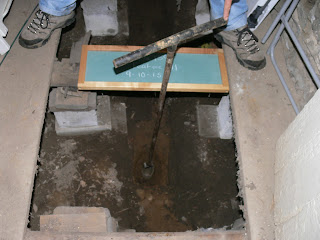We have been busy with our excavations at Fort Hunter and
have enjoyed some incredibly good weather.
The interest from the local community is terrific with close to 3,000
visitors last Sunday during Fort Hunter Day.
Our daily visitors at the site include school groups and home school
students who want to see archaeologists at work. We hosted Commonwealth Connections Academy
this week as well as two large groups of home school students. All of our visitors are enthusiastic and
engaged in our excavations and we appreciate their enthusiasm. If you haven’t had an opportunity to stop by
the site, we close our excavation next week on October 2nd, 2015.
 |
| Visitors to Fort Hunter Day |
 |
| Junior Archaeologist during Commonwealth Connections Day |
Our last blog described our investigation of the building
identified as an Ice House on site maps and our doubts concerning its
function. Research conducted this spring
provides our most plausible answer to the mystery of this building’s function.
The following excerpt describing a milk house on Archibald McAllister’s property in
1828 for the publication The Cultivator offers
the following;
·
The Milk-house
was built in the north-east side of a slope, near the well and not far from the
mansion. It was composed a stout stone walls, and the roof, which rose 6 or 3
feet above the surface of the ground, appeared to be covered with earth or
tile, and was deeply shrouded with the scarlet trumpet creeper (Bignonia
radicans), then in splendid bloom. The interior of the house, principally under
ground, was fitted up with cistern, in which water stood nearly to the tops of
the pans of milk, which were arranged in them. The house was entered by a
flight of steps on the south, and there was a window on the north, which could
be opened or darkened at pleasure, to give ventilation. For want of a natural
spring, which many Pennsylvanians consider almost indispensable in a milk
house, the water was conducted in a pipe from the well-pump, and after filling
the cisterns to a certain height, passed off at the opposite side. The object
was to obtain a cool temperature, in the heat of summer, which greatly
facilitates the separation of the cream from the milk, and this object was
amply effected, with the labor of working occasionally at the well-pump.
 |
| Interior of Ice House / Milk House |
 |
| 1890’s photo of badminton game with building at rear of photo |
While difficult to see in early photos of the property,
there does appear to be vegetation overhanging the side of this structure in
the above photo. Later images of dogs
from this area of the yard also show signs of a large plant which we are
surmising is the trumpet vine referred to in the article.
This week the interior was cleared of the floor boards and
the artifacts recovered were a mixed assortment of late 19th and 20th
century materials. The exposed brick
floor has been swept and additional measurements of the structure were taken
yesterday. Visitors this week included
our architects and architectural historians from the PHMC who examined the structure
and support our designation of the structure as a milk-house. Our interns this semester will be working on a
detailed drawing of the structure and we will continue to research photos and
documents before definitively stating that this is its function, but again this
seems to be a plausible identification.
We are continuing to dig along the east side of the porch,
directly in front of the original stone house structure and have recovered
several glass trade beads. Historic
documents indicate that there were several meetings held at the site with
Indians and that trade was occurring in the area. Joseph Chambers and Simon Girty were both
licensed to trade in 1747-1748 in Paxtang Township which was the original
township for Fort Hunter. Several
features have been exposed in this area which we are continuing to investigate
and will report those findings in our next blog.
 |
| Porch Area |
 |
| Trade Beads found in Porch Area Excavations |
The foundation is almost completely exposed of a structure
currently identified as a smokehouse.
Historic documents reference an octagonal shaped smokehouse on the
property in 1828 and the dimensions are relatively close to the
description. There is a great deal of
work to do in this block as there are multiple features which require careful
excavation and mapping to insure that the proper function is assigned. Removing the previously excavated soil to the
south and east of our block has provided an opportunity to look at the entire
foundation. The diameter of this circular
foundation measures just over 13 feet.
Certainly additional research will continue on this area, but the image
of this foundation is pretty impressive.
 |
| Circular foundation on east side of “ice house” |
We hope you’ve enjoyed this update on our investigation at
Fort Hunter and will stop out to visit or check back on our blog to see what
next week’s excavation might reveal about this historic site. As a reminder-
October is Archaeology Month in Pennsylvania http://www.pennsylvaniaarchaeology.com/ArchMonth.htm so please seek out an opportunity to visit a
site or to read more about the heritage of your community as provided in the
archaeological record.
For more information, visit PAarchaeology.state.pa.us or the Hall of Anthropology and Archaeology at The State Museum of Pennsylvania .







